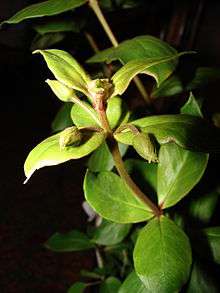Lysimachia maxima
| Lysimachia maxima | |
|---|---|
 | |
| Scientific classification | |
| Kingdom: | Plantae |
| (unranked): | Angiosperms |
| (unranked): | Eudicots |
| (unranked): | Asterids |
| Order: | Ericales |
| Family: | Primulaceae |
| Genus: | Lysimachia |
| Species: | L. maxima |
| Binomial name | |
| Lysimachia maxima (R.Knuth) H.St.John | |
Lysimachia maxima is a rare species of flowering plant in the family Primulaceae known by the common name Pelekunu Trail yellow loosestrife.[1] It is endemic to Hawaii, where there are only two small populations remaining on the island of Molokai.[2] It is federally listed as an endangered species of the United States.
This is a shrub with sprawling branches lined with leaves growing in clusters of three. The solitary flowers are purple in color.[3] The plant grows only in the wet forests of the Pelekunu Mountains of Molokai. The most recent surveys revealed a total of twenty individuals, ten in each of the two populations.[2]
The plant is threatened by the invasion of introduced species of animals such as feral pigs and feral goats, and plants such as Koster's curse (Clidemia hirta) in its habitat.[2] The plant is vulnerable because of its small numbers; a single event could conceivably cause its extinction.[2]
Officials have released the leaf-eating insect Lius poseidon into the habitat as an agent of biological pest control against Koster's curse. It is too early to determine how successful this effort has been.[2]
References
- ↑ USDA Plants Profile
- 1 2 3 4 5 USFWS. Lysimachia maxima Five-year Review. January 2008.
- ↑ Lysimachia maxima. The Nature Conservancy.
| Wikimedia Commons has media related to Lysimachia maxima. |
